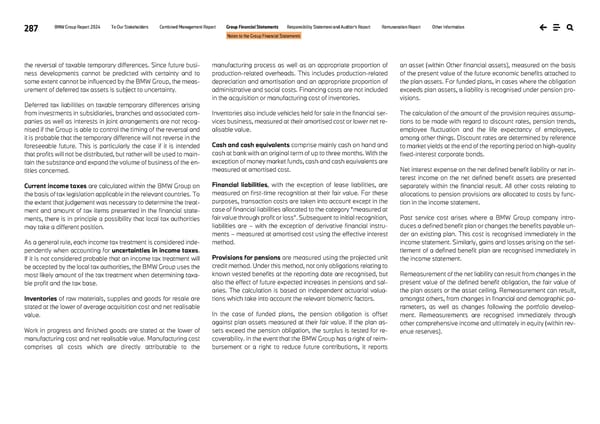287 BMW Group Report 2024 To Our Stakeholders Combined Management Report Group Financial Statements Responsibility Statement and Auditor’s Report Remuneration Report Other Information Notes to the Group Financial Statements the reversal of taxable temporary differences. Since future busi- ness developments cannot be predicted with certainty and to some extent cannot be influenced by the BMW Group, the meas- urement of deferred tax assets is subject to uncertainty. Deferred tax liabilities on taxable temporary differences arising from investments in subsidiaries, branches and associated com- panies as well as interests in joint arrangements are not recog- nised if the Group is able to control the timing of the reversal and it is probable that the temporary difference will not reverse in the foreseeable future. This is particularly the case if it is intended that profits will not be distributed, but rather will be used to main- tain the substance and expand the volume of business of the en- tities concerned. Current income taxes are calculated within the BMW Group on the basis of tax legislation applicable in the relevant countries. To the extent that judgement was necessary to determine the treat- ment and amount of tax items presented in the financial state- ments, there is in principle a possibility that local tax authorities may take a different position. As a general rule, each income tax treatment is considered inde- pendently when accounting for uncertainties in income taxes. If it is not considered probable that an income tax treatment will be accepted by the local tax authorities, the BMW Group uses the most likely amount of the tax treatment when determining taxa- ble profit and the tax base. Inventories of raw materials, supplies and goods for resale are stated at the lower of average acquisition cost and net realisable value. Work in progress and finished goods are stated at the lower of manufacturing cost and net realisable value. Manufacturing cost comprises all costs which are directly attributable to the manufacturing process as well as an appropriate proportion of production-related overheads. This includes production-related depreciation and amortisation and an appropriate proportion of administrative and social costs. Financing costs are not included in the acquisition or manufacturing cost of inventories. Inventories also include vehicles held for sale in the financial ser- vices business, measured at their amortised cost or lower net re- alisable value. Cash and cash equivalents comprise mainly cash on hand and cash at bank with an original term of up to three months. With the exception of money market funds, cash and cash equivalents are measured at amortised cost. Financial liabilities, with the exception of lease liabilities, are measured on first-time recognition at their fair value. For these purposes, transaction costs are taken into account except in the case of financial liabilities allocated to the category “measured at fair value through profit or loss”. Subsequent to initial recognition, liabilities are – with the exception of derivative financial instru- ments – measured at amortised cost using the effective interest method. Provisions for pensions are measured using the projected unit credit method. Under this method, not only obligations relating to known vested benefits at the reporting date are recognised, but also the effect of future expected increases in pensions and sal- aries. The calculation is based on independent actuarial valua- tions which take into account the relevant biometric factors. In the case of funded plans, the pension obligation is offset against plan assets measured at their fair value. If the plan as- sets exceed the pension obligation, the surplus is tested for re- coverability. In the event that the BMW Group has a right of reim- bursement or a right to reduce future contributions, it reports an asset (within Other financial assets), measured on the basis of the present value of the future economic benefits attached to the plan assets. For funded plans, in cases where the obligation exceeds plan assets, a liability is recognised under pension pro- visions. The calculation of the amount of the provision requires assump- tions to be made with regard to discount rates, pension trends, employee fluctuation and the life expectancy of employees, among other things. Discount rates are determined by reference to market yields at the end of the reporting period on high-quality fixed-interest corporate bonds. Net interest expense on the net defined benefit liability or net in- terest income on the net defined benefit assets are presented separately within the financial result. All other costs relating to allocations to pension provisions are allocated to costs by func- tion in the income statement. Past service cost arises where a BMW Group company intro- duces a defined benefit plan or changes the benefits payable un- der an existing plan. This cost is recognised immediately in the income statement. Similarly, gains and losses arising on the set- tlement of a defined benefit plan are recognised immediately in the income statement. Remeasurement of the net liability can result from changes in the present value of the defined benefit obligation, the fair value of the plan assets or the asset ceiling. Remeasurement can result, amongst others, from changes in financial and demographic pa- rameters, as well as changes following the portfolio develop- ment. Remeasurements are recognised immediately through other comprehensive income and ultimately in equity (within rev- enue reserves).
 BMW Group Report 2024 Page 286 Page 288
BMW Group Report 2024 Page 286 Page 288